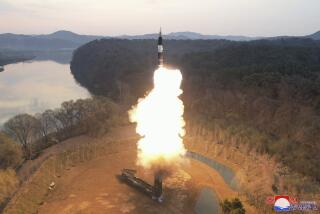China flight-tests stealth jet during Gates’ visit
- Share via
Reporting from Beijing — China’s military conducted the first flight test of an experimental stealth fighter Tuesday, apparently without informing the country’s civilian leadership in advance and only hours before Defense Secretary Robert M. Gates met with the Chinese president to discuss improving military ties.
The test flight of the J-20 fighter seemed to represent a snub of Gates from China’s military establishment during his three-day visit to Beijing and to deepen questions about how much control its civilian leadership exercises over the armed forces, which have often taken a harder line on improving relations with the U.S.
When Gates mentioned the test in an afternoon meeting with President Hu Jintao at the Great Hall of the People, it was initially clear that neither Hu nor any of the other Chinese civilian officials present were aware that it had occurred, according to a senior U.S. Defense Department official.
After confirming the test flight, Hu told Gates that it was not timed to coincide with his visit.
“He said that the test had absolutely nothing to do with my visit and had been a pre-planned test, and that’s where we left it,” Gates told reporters shortly after the meeting. Gates added that he “takes President Hu at his word.”
U.S. officials refused to speculate about why the test flight occurred when it did.
Separately, Gates also warned Tuesday that North Korea’s nuclear and missile programs were making it a greater threat to the United States and that it was within five years of developing a ballistic missile that could strike the continental United States.
“North Korea is becoming a direct threat to the United States,” he said, adding, “I don’t think it’s an immediate threat, but on the other hand I don’t think it’s a five-year threat.”
Gates said it was unlikely that North Korea would have a large arsenal of nuclear-armed missiles, but that the development of even a small number was something the U.S could not ignore. Gates said he raised the subject of how to deal with North Korea at his meeting with Hu.
He added that North Korea’s artillery barrage against a South Korean island in November and other provocative acts had made the need to ease tensions on the Korean peninsula “a matter of some urgency.”
He credited China with pressuring Pyongyang to ease tensions. Earlier this month, Pyongyang said it would support negotiations without preconditions with South Korea. But Gates said North Korea needs to take concrete actions, such announcing a moratorium on missile testing or on nuclear tests, before expecting the U.S. and its allies to agree to resume diplomatic contacts.
“Rhetoric is not enough at this point. I think there needs to be some concrete actions to demonstrate they are serious,” he said.
The timing of China’s test flight of its stealth fighters, in the midst of a visit in which Gates hopes to improve strained military ties, appeared to indicate that some within the Chinese military establishment continue to see the two nations more as rivals than as potential partners, as do some within the U.S. government.
The test was the latest in a series of Chinese military incidents, including a 2007 anti-satellite missile test and a 2009 confrontation between Chinese vessels and a U.S. warship in the South China Sea, in which civilian leaders in Beijing appeared unaware or poorly informed about their armed forces.
Gates said the test points up the importance of the Pentagon establishing better dialogue with the Chinese military. But he said that doing so would be a lengthy process, not one “where you will see dramatic breakthroughs.”
Even so, after meeting with Hu and other senior Chinese civilian and military leaders, Gates said he had “a very positive visit.” He added “that the Chinese, including the PLA, are prepared to move forward with a much richer agenda of cooperative activities,” using the acronym for the People’s Liberation Army.
Photos of the jet aloft were posted Tuesday on unofficial Chinese military websites and by Global Times, a state-run newspaper. The first photos appeared in public last week, but showed it only on a runway at an airbase in the city of Chengdu, leading to speculation that the test flight had been canceled for technical reasons.
Gates had cited the J-20 while traveling to Beijing as one of the several Chinese weapons programs that could put U.S. forces at risk in the future and said that U.S. intelligence may have underestimated how far along the Chinese are in development of the experimental aircraft.
But he also raised doubts about whether, despite China’s claim, the plane would prove able to avoid detection on radar, a technology that the U.S. accomplished decades ago.
Gates’ meeting with Hu came a week before the Chinese leader is scheduled to travel to Washington for talks with President Obama.
More to Read
Sign up for Essential California
The most important California stories and recommendations in your inbox every morning.
You may occasionally receive promotional content from the Los Angeles Times.














